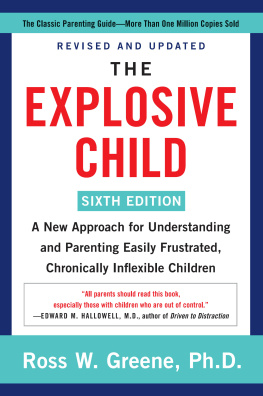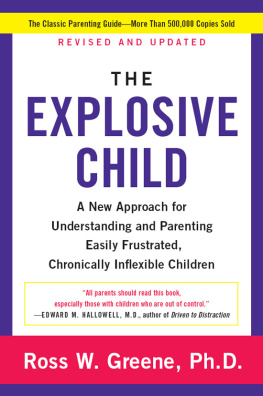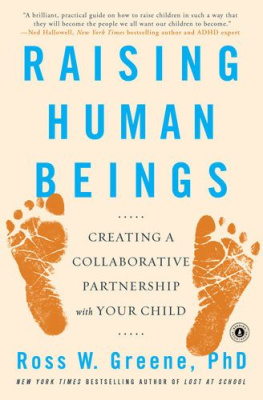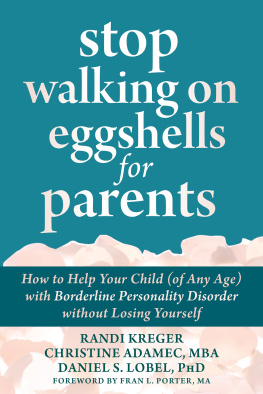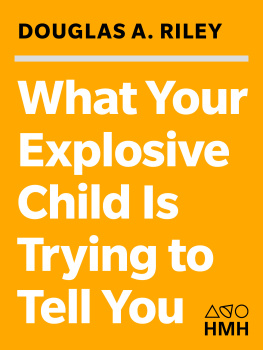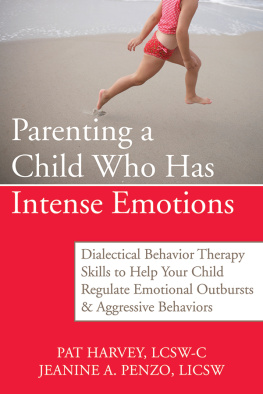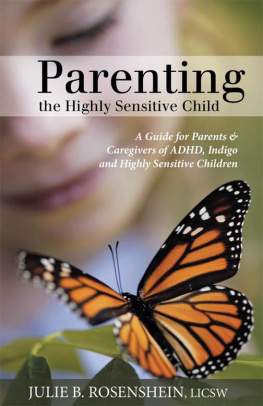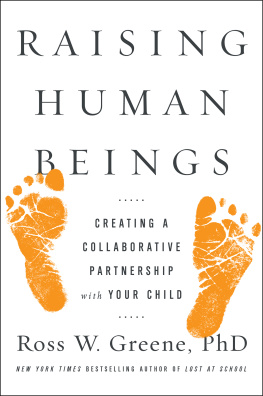In memory of my father, Irving A. Greene
Anyone can become angry, that is easy... but to be angry with the right person, to the right degree, at the right time, for the right purpose, and in the right way... this is not easy.
ARISTOTLE
Do the best you can until you know better. Then when you know better, do better.
MAYA ANGELOU
Contents
Lost at School
Lost & Found
Raising Human Beings
ROSS W. GREENE, PH.D., is a clinical psychologist and the originator of the innovative, evidence-based approach called Collaborative & Proactive Solutions (CPS), as described in this book. He also developed and executive produced the award-winning documentary film The Kids We Lose, released in 2018. Dr. Greene was on the faculty at Harvard Medical School for more than twenty years and founded the nonprofit Lives in the Balance in 2009. He is currently adjunct professor in the Department of Psychology at Virginia Tech and adjunct professor in the Faculty of Science at the University of Technology in Sydney, Australia. Dr. Greene has worked with several thousand behaviorally challenging kids and their caregivers, and he and his colleagues have overseen implementation and evaluation of the CPS model in hundreds of schools, inpatient psychiatry units, and residential and juvenile detention facilities, with dramatic effect: significant reductions in recidivism, discipline referrals, detentions, suspensions, and use of restraint and seclusion. Dr. Greene lectures throughout the world and lives in Freeport, Maine.
Discover great authors, exclusive offers, and more at hc.com.
This book is written as a source of information only and should not be considered a substitute for the advice, decisions, or judgment of a qualified mental health professional. All efforts have been made to ensure the accuracy of the information contained in this book as of the date published. The author and the publisher expressly disclaim responsibility for any adverse effects arising from the use or application of the information contained herein.
THE EXPLOSIVE CHILD. Copyright 1998, 2000, 2005, 2010, 2014, 2021 by Ross W. Greene, Ph.D. All rights reserved under International and Pan-American Copyright Conventions. By payment of the required fees, you have been granted the nonexclusive, nontransferable right to access and read the text of this e-book on-screen. No part of this text may be reproduced, transmitted, downloaded, decompiled, reverse-engineered, or stored in or introduced into any information storage and retrieval system, in any form or by any means, whether electronic or mechanical, now known or hereafter invented, without the express written permission of HarperCollins e-books.
Cover design by Amanda Kain
All illustrations by Greg Daly
Digital Edition AUGUST 2021 ISBN: 978-0-06-309247-1
Version 06252021
Print ISBN: 978-0-06-309246-4 (pbk.)
Australia
HarperCollins Publishers Australia Pty. Ltd.
Level 13, 201 Elizabeth Street
Sydney, NSW 2000, Australia
www.harpercollins.com.au
Canada
HarperCollins Publishers Ltd
Bay Adelaide Centre, East Tower
22 Adelaide Street West, 41st Floor
Toronto, Ontario, M5H 4E3
www.harpercollins.ca
India
HarperCollins India
A 75, Sector 57
Noida
Uttar Pradesh 201 301
www.harpercollins.co.in
New Zealand
HarperCollins Publishers New Zealand
Unit D1, 63 Apollo Drive
Rosedale 0632
Auckland, New Zealand
www.harpercollins.co.nz
United Kingdom
HarperCollins Publishers Ltd.
1 London Bridge Street
London SE1 9GF, UK
www.harpercollins.co.uk
United States
HarperCollins Publishers Inc.
195 Broadway
New York, NY 10007
www.harpercollins.com
Contents
Guide
Welcome to the 2021 edition of The Explosive Child, which comes twenty-three years after the first edition was published in 1998. A lot has happened during those years. The book is now published in dozens of languages. The model described in these pages has undergone one decidedly uncollaborative name change. (It was originally named Collaborative Problem Solving, but is now called Collaborative & Proactive Solutions.) The CPS model has been implemented by hundreds of thousands of families and thousands of schools, inpatient psychiatry units, and residential and juvenile detention facilities throughout the world. Numerous published studies have documented its effectiveness, and it has been validated as an evidence-based intervention. Because of various refinements over the years, the model is easier to understand and implement. This edition reflects the most current iteration. In an effort to be sensitive to different preferences, the book is written using male, female, and gender nonspecific pronouns in alternating chapters.
Ill start off by acknowledging that Ive never been a huge fan of the title of the book. Explosive is just a descriptive term for kids who become frustrated far more easily and more often than ordinary kids, and communicate their frustration in ways that are far more extreme (screaming, swearing, spitting, hitting, kicking, biting, cutting, destroying property). But explosive is a clumsy adjective for several reasons. First, it implies that the outbursts of these kids are sudden and unpredictable andthis may be a little hard to believe at firstthats actually not true most of the time. Second, while many kids explode when theyre frustrated, many others implode instead (crying, sulking, whining, pouting, avoiding, withdrawing, or being worried or anxious). The title of the book notwithstanding, the strategies described herein are applicable to kids who are exploding, imploding, or some combination of the two.
But the behaviors arent even the most important part. Rather, what those behaviors are telling us is the most important part. And what theyre telling us is that your child is having difficulty meeting certain expectations. Some kids withdraw when there are expectations theyre having difficulty meeting (otherwise they dont withdraw). Other kids hit when there are expectations theyre having difficulty meeting (otherwise they dont hit). While its tempting to focus on your childs behaviors, in this book well be focusing instead on the expectations they are having difficulty meeting that are causing those behaviors. That crucial distinction is going to make a world of difference.
One of the things youll learn in the early chapters of the book is that the terms that have commonly been used to characterize kids with concerning behaviorsterms such as willful, manipulative, attention-seeking, limit-testing, contrary, intransigent, unmotivatedare inaccurate and counterproductive. Youll also read that a lot of the things weve been saying about the parents of these kidsthat theyre passive, permissive, inconsistent, noncontingent, inept disciplinariansarent accurate or productive either. And youll learn that the psychiatric diagnoses that may have been applied to your child dont provide the information you need to accurately understand their difficulties and effectively help them.
This may sound a little strange, but theres never been a better time to be living or working with a child with concerning behaviors. Thats because an enormous amount of research on kids with concerning behaviors has accumulated over the past fifty years, so we know a lot more about why and when theyre struggling and how to help them than at any other point in human evolution. The research provides us with new lenses through which to view their difficulties, and those new lenses can help you respond to and help these kids in ways that are more compassionate, productive, and effective. Thats the good news. The bad news is that the new lenses can take some getting used to (after all, theres a decent chance youve been wearing different lenses for a very long time). So, youll need an open mind. Also, the strategies contained in this book can be quite a departure from the norm and may differ from the way you were raised, so theyll likely require some practice (and patience), as you and your child become accustomed to new ways of interacting and solving problems.
Next page
